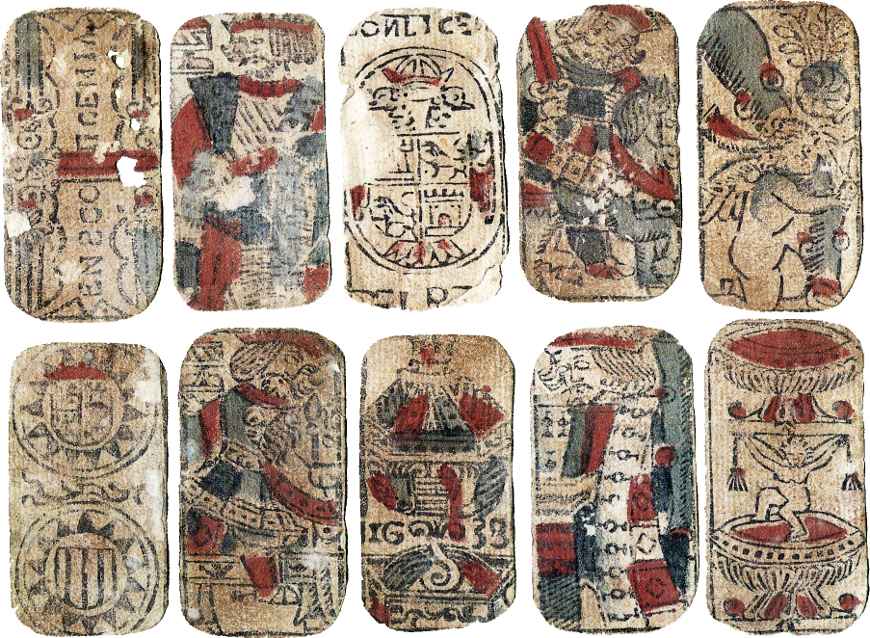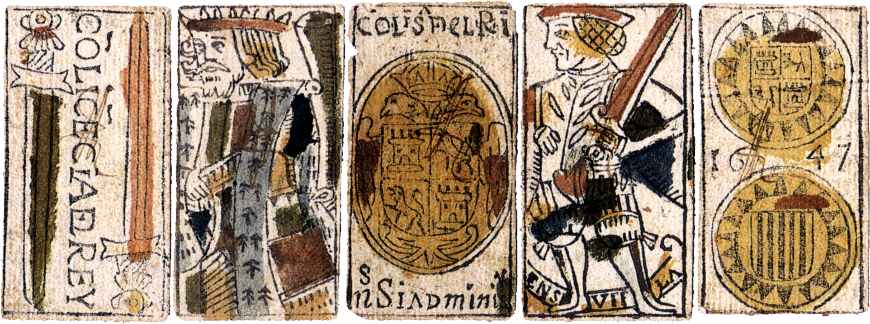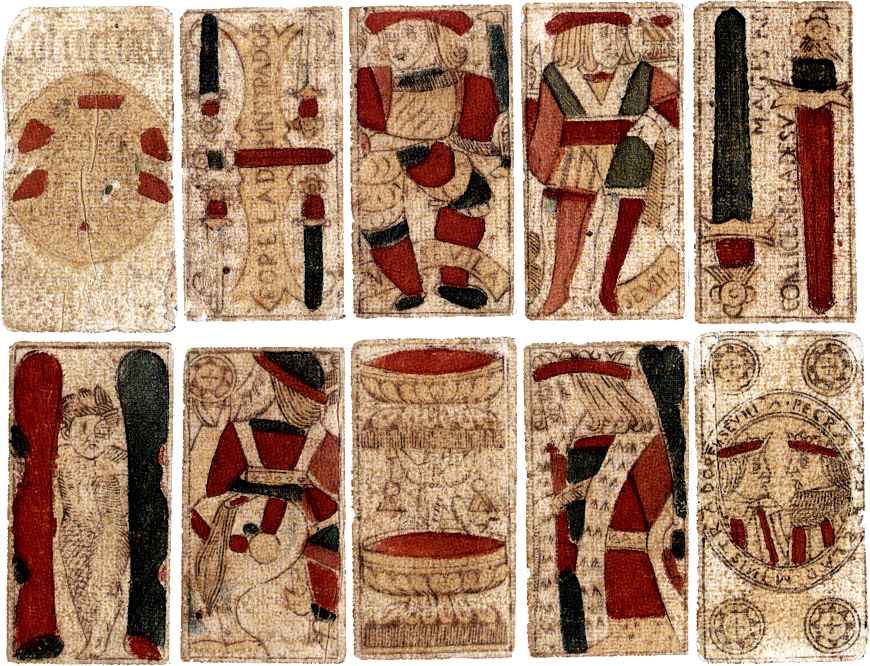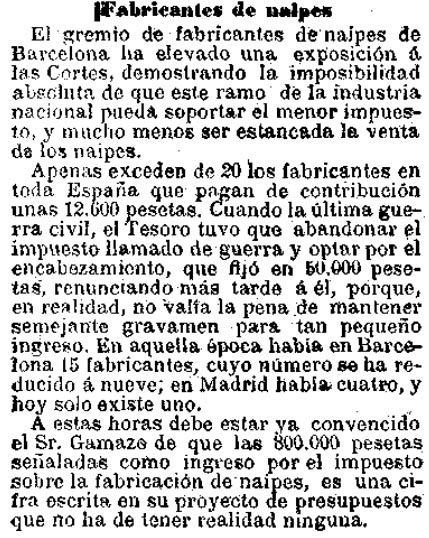Taxation on Spanish Playing Cards
Taxation on Spanish playing cards and the monopolies.
Origins of Taxation on Spanish Playing Cards
The Spanish playing card monopoly was first established in 1543. It was divided into several regions including Aragon, Toledo, Castile, Seville as well as Mexico and ‘New Spain’. Leases for these respective monopolies were awarded on a competitive basis to the highest bidder and subject to strict controls. Lease holders also enjoyed the protection of laws governing the playing card monopolies, which included the outlawing of contraband playing cards and protection against Moors, Turks, Pirates, Corsairs and enemies of the Catholic Faith. Manufacturers were required to sell their packs of playing cards at prices controlled by law. Whilst the different regional monopolies were subject to different fiscal and administrative regimes, it is not clear whether any regional differences existed in the style or design of the playing cards themselves.
Catalonia had a local tax in the 17th century, at least since 1613. The assignment of the lease on May 8, 1628, also involved cards imported from France, but more from Castile. Card makers registered samples of their production. For export, cards and packaging had to be marked.
Until the 19th century, there were forms of monopoly on making and selling cards. The last one was the Real Fábrica de Naipes, the Royal Card Factory of Madrid (18th century - beginning of the 19th century). Its marking "RL FB DE MD" can be read on some packs. Imitations, e.g., made in Turnhout, had the spelling "RL EA DE MD".
Sevilla, XVII Century

Above: Spanish playing cards, woodcut & stencil, Seville, dated 1638 on the Ace of Cups. The Ace of Batons and the Two of Cups have small naked figures adorning the suit symbols. The Ace of Coins has a two-headed imperial eagle. Inscriptions on the cards read: "En S (en Sevilla) Con Licencia del Rey." These cards were discovered inside a wall during the demolishing of the former Granada prison, and were probably handled by gambling card players running a racket inside jail. Image of cards in the Fournier Museum, Alava, taken from: Agudo Ruiz: Los Naipes en España, Diputación Foral de Álava, 2000.
Revenues from the Seville playing card monopoly, which also included Granada and the Canary Isles, reached twelve million maravedis when it was acquired by Francisco de Zayas for a ten year tenure. Cards made in Seville during this period have official signatures on certain cards as proof of taxes paid to the treasury.

Above: Spanish playing cards, woodcut & stencil, made in Seville, dated 1647 on the Two of Coins. Official signatures on certain cards were proof that taxes had been paid to the treasury. Image of cards in the Fournier Museum taken from: Agudo Ruiz: Los Naipes en España, Diputación Foral de Álava, 2000.

Above: Spanish playing cards, woodcut & stencil, made in Seville, late XVII centiry. Several cards bear legends relating to the royal licence for the administration of the sale of playing cards. Two Sotas also have banderoles with the text 'En Sevilla'. Image of cards in the Fournier Museum taken from: Agudo Ruiz: Los Naipes en España, Diputación Foral de Álava, 2000.
Seville was a favoured location by gamblers read more →

References: Agudo Ruiz, Juan de Dios: Los Naipes en España, Diputación Foral de Álava, 2000
See also: Gothic Spanish-suited cards • Phelippe Ayet/Jean Pouns • Navarra 17th Century • The Spanish National pattern • The Money Bag pattern • Rotxotxo Workshop Inventories, Barcelona • Real Fábrica de Macharaviaya • José Gombau, 1833 • Sanmarti, 1840 • Maciá Pattern • José Martinez de Castro (Madrid) • Fournier Hermanos (Burgos) 1860 • Heraclio Fournier S.A. (Vitoria) • Baraja de Amor, Hijos de Taboadela, 1871 • Hija de B. Fournier (Burgos) • Ibero-American Deck • Antonio Moliner (Burgos) 1890 • French Catalan pattern • S. Giráldez (Barcelona) c.1910 • Simeon Durá (Valencia) • Belgian Spanish Cards • República Española Souvenir • Vic Joc de Cartes, 1990

By Simon Wintle
Member since February 01, 1996
I am the founder of The World of Playing Cards (est. 1996), a website dedicated to the history, artistry and cultural significance of playing cards and tarot. Over the years I have researched various areas of the subject, acquired and traded collections and contributed as a committee member of the IPCS and graphics editor of The Playing-Card journal. Having lived in Chile, England, Wales, and now Spain, these experiences have shaped my work and passion for playing cards. Amongst my achievements is producing a limited-edition replica of a 17th-century English pack using woodblocks and stencils—a labour of love. Today, the World of Playing Cards is a global collaborative project, with my son Adam serving as the technical driving force behind its development. His innovative efforts have helped shape the site into the thriving hub it is today. You are warmly invited to become a contributor and share your enthusiasm.
Related Articles

Pierre Varangot
Tracing the origins, legality and legacy of Pierre Varangot’s San Sebastián deck.

Archaic Spanish-suited pattern from Bayonne
Archaic Franco-Spanish pattern from Bayonne by a manufacturer with the initals M.V.

Tarot de las Coscojas
Historical playing card design, tarot symbolism and an almost psychedelic medieval surrealism.

Tarot de Valverde de la Vera
A series of 24 surrealist engravings by Mexican artist Claudio Favier in which archetypal Tarot alle...

Baraja de Juan Martín Zamorano
Deck inspired by El Pendón de los Zamorano, a military pennant dating from 1501, published by Priego...

Heráldica Castanyer No. 16
Strange variant of international pattern cards for poker or bridge.

Fantasy Spanish-suited deck
Fantasy Spanish-suited deck by Bertschinger y Codina, Barcelona.

Trappola cards from Poland
Trappola cards published in Warsaw by J G Du Port during the 18th century.

Bertschinger y Codina - Cartes Françaises
French ‘Paris’ pattern made by Bertschinger y Codina, Barcelona, c.1850.

Braulio Fournier
Baraja Nº 1 produced by Braulio Fournier, Burgos, c.1868.

Pirritx eta Porrotx
Happy Families card game from the Spanish Basque Country.

Naipe Vizcaino
‘Naipe Vizcaino’ designed by Javier Urkiri and published by Industrias Gráficas Castuera and the Caj...

Spanish pattern by Eugène Boisse
Spanish pattern published by Eugène Boisse, Bordeaux.

Baraja Turística del País Vasco
Basque poker deck of 55 cards published by Fournier with scenic views of the Basque Country.

Baraja Vasca
Spanish Basque Country deck with original drawings by María Isabel Ibañez de Sendadiano.

Baraja Cultura Española
ASESCOIN pack for 2022 designed by M.A. Corella featuring famous Spaniards and notable buildings.
Most Popular
Our top articles from the past 28 days

